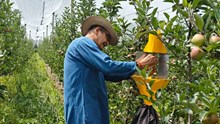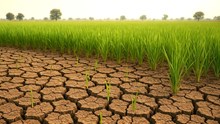
Life in desert areas has never been easy. With hot temperatures, scarce rainfall, and poor soils, few crops can survive. But the Khejri tree is a remarkable exception. It is also known as "Kalpavriksha of the Desert", it flourishes even when the soil around it dries up to dust.
Each year, during the scorching summer season of April to June, the Khejri tree yields long, thin pods known as Sangri. The green pods are picked off when immature and tender. These immature pods are the origin of one of Rajasthan's favorite dishes – ker-sangri, a traditional dish known for its pungent, spicy taste and very high nutritional value.
Sangri – A Nutritional Powerhouse
Sangri pods are more than just a food item. More importantly, they are a survival food that nourished desert communities for centuries. High in protein, calcium, iron, and vital vitamins, Sangri tends to fill up nutritional gaps during times when proper vegetables are limited.
Sangri is dried for months and reserved for use during periods when the fresh vegetables are not in stock. It has thus become the lifeline to families in harsh summers and drought periods.
A Boon for Women and Rural Livelihoods
The harvesting and drying of Sangri pods are mostly done by rural women and small scale farmers. In Rajasthan alone, thousands of women from self-help groups and village communities engage in the seasonal activity of picking tender Sangri pods, sun-drying them, and preparing them for market sale.
Since Sangri has no chemical input, fertilizers, or irrigation needed, its collection is cost-free and eco-friendly. It earns a seasonal income of between Rs. 15,000 and Rs. 50,000 depending on the yield and market price.
Some farmer producer organizations and women's SHGs have begun value addition by washing, grading, and packaging Sangri in clean conditions, selling them to urban markets and online platforms. The demand for such traditional desert foods as ker-sangri is growing not only in India but also among the Indian diaspora worldwide.
How Farmers Can Benefit from Khejri Tree Plantation
Farmers who already have Khejri trees on their farms tend to view them as shade trees or boundary trees. These trees can be turned into income-generating assets but with proper knowledge and care.
Khejri is resistant to drought, fixes the nitrogen in the soil, and enhances the fertility of soil for intercrops. Farmers can intercrop Bajra (Pearl Millet), Moth bean, and Guar in the regions around Khejri plantations. Young crops are also shielded by the shade provided by Khejri from intense sun.
For farmers looking to develop agroforest or for those who wish to earn from idle lands, growing Khejri trees can be a dual-purpose venture which is soil conservation and income generation in the long term. One mature tree yields 10 to 15 kg of Sangri pods annually in a good year. With 20-30 trees, a farmer can generate a reasonable seasonal income without any cost of input.
Value Addition and Branding
Sangri is traditionally sold in local markets, usually loosely packed. But the real income potential comes through value addition and branding. If farmers and SHGs collaborate to produce branded, hygienically packed Sangri products, their market value can be doubled or even tripled.
Some cooperatives and startups in Rajasthan are already engaged with rural women to produce beautiful Sangri packets, along with recipes and local spice blends. These are sold in urban superstores and on the internet with organic and GI-tagged brands.
Training in drying process, grading, packaging, and elementary marketing can enable more youth and women to make Sangri a branded product line. Such efforts can be aided by government schemes such as NRLM (National Rural Livelihood Mission) and Van Dhan Yojana.
Challenges and the Way Forward
Even with its potential, Sangri collection continues to have some challenges. In certain regions, Khejri trees are being cut for firewood or to clear land for roads and buildings. There is also a lack of awareness among farmers regarding the commercial value of these trees.
To safeguard this desert gem, we require people's participation through conservation of Khejri, increased plantation drives, and agroforestry education. Local Krishi Vigyan Kendras (KVKs) and NGOs should conduct farmer orientation programs on the collection of Sangri, post-harvest management, and marketing.
Sangri is more than simply a bean, it is a symbol of resilience, heritage, and rural empowerment. It provides a unique blend of nutritional value, income, and environmental advantages for growers in arid regions. Crops like Sangri might provide hope in an era when farming is becoming more difficult due to climate change.
















